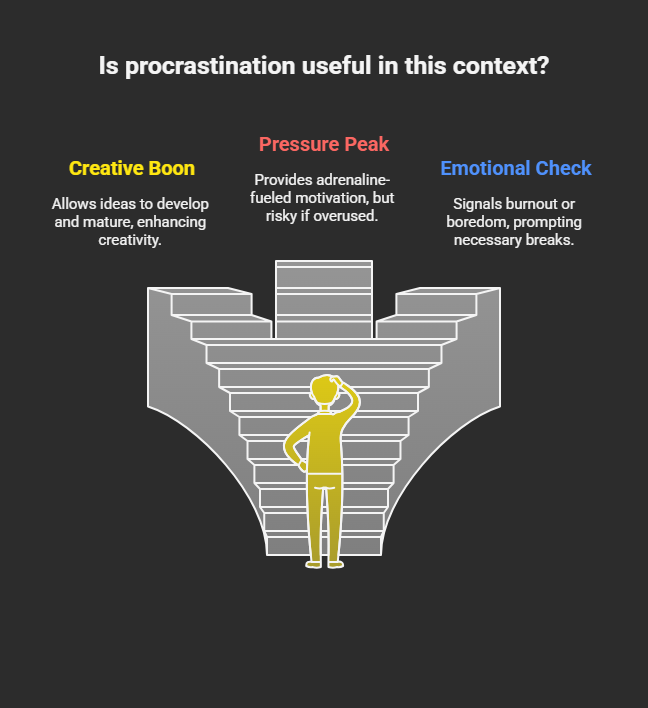Procrastination. The ultimate buzzkill. Yet, hear me out, it isn’t always the villain it’s painted to be. Sometimes, dodging that looming, high-stakes assignment can spark a flurry of other, surprisingly useful tasks. Curious? Let’s spill the beans on “productive procrastination,” that quirky cousin of classic avoidance, and figure out whether setting aside one chore can help you tick off a laundry list of others.
What Is Productive Procrastination, Anyway?
Believe it or not, there’s a thing called active procrastination, also cheekily dubbed good procrastination. Rather than binge-watching an entire season of your favorite show when you should be drafting that report, you tackle smaller, meaningful tasks. Think: organizing your desktop, replying to overdue emails, tidying your workspace…you get the drift.
- Definition in a Nutshell: Choosing to postpone a priority task but using that time to do alternative tasks that still move you forward.
- Key Distinctions:
- Passive procrastination = scrolling social media, doomscrolling the news, falling down rabbit holes.
- Active procrastination = swapping one obligation for another that’s still, y’know, productive.
- Passive procrastination = scrolling social media, doomscrolling the news, falling down rabbit holes.
Here’s the kicker: when you’re stuck, staring blankly at a blinking cursor, switching gears might actually thaw that creative freeze. It’s like stepping outside for fresh air mid-panic attack. Suddenly…clarity.
The Psychology Behind Active Procrastination
Why We Dodge the Big Stuff
Let’s get real. Big tasks scare us, especially when the stakes feel sky-high. By the time you gear up mentally (after that all-night pep talk in the shower), you’ve clocked three hours of mental somersaults. Ugh.
- Fear of Failure: What if it’s not perfect?
- Overwhelm: The task is so massive, you don’t know where to start.
- Perfectionism: You’d rather wait for the “perfect moment” than dive in and risk mistakes.
And so…you stall. But if you stall smartly, you might just end up being kind of a hero to your inbox, your calendar, or even your laundry basket.
The Science, Briefly
Researchers have found that active procrastinators, unlike chronic dawdlers, tend to be more motivated overall, have clearer goals, and manage time more effectively. (Yes, really.) They actually choose to delay tasks, rather than being paralyzed by indecision.
- Study Snapshot: In one survey, participants who identified as active procrastinators reported higher levels of satisfaction with their performance compared to those who passively put things off.
- Brain Hack: Switching tasks can activate different neural circuits, giving your prefrontal cortex (that brain’s “executive lounge”) a chance to reset.
Still, all that glitters isn’t gold, so let’s weigh the pros and cons.
Pros of Productive Procrastination
1. Momentum Builder
Funny thing is, once you knock out a couple of smaller chores, you often feel empowered, energized, even to tackle that main event.
- Boosted Confidence: “Look at me, conquering spreadsheets!”
- Endorphin Rush: Every checkmark feels like a mini-win.
2. Decision Fatigue Fighter
When your brain’s fried, making big decisions feels like wading through molasses. Little tasks? They’re quick, they’re clear, and they don’t demand much mental horsepower.
- Quick Wins: Less mental toll.
- Clear Outcomes: Done = done.
3. Reduced Anxiety
Oddly enough, ticking some boxes, even unrelated ones, can soothe that bubbling anxiety over the looming deadline. It’s a distraction that heals.
- Lower Stress Hormones: Brief breaks (err, alternative tasks) can calm cortisol levels.
- Switching Gears: Gives your mind a breather.
4. Skill Diversification
Here’s where it gets interesting: sometimes, the tasks you choose sharpen skills that ultimately help with the bigger project.
- Organizational Mojo: Cleaning your workspace might improve focus.
- Communication Warm-Up: Drafting those emails plumps up your writing muscles.
Cons and Risks: Don’t Get Too Cocky
1. Slippery Slope to Time Sink
Ever meant to “just check” your inbox for five minutes? And then, bam, it’s half an hour later. Next thing you know, you’ve cleaned the entire house. Productive? Maybe. But your main task? Still untouched.
- Time Budget Blowout: Alternative tasks morph into distractions.
- Scope Creep: A quick switch becomes a deep dive.
2. False Sense of Progress
Those checkmarks feel good…maybe too good. You might convince yourself you’re on fire, but if the core task remains unstarted, you’re in trouble.
- Illusion of Productivity: Feels like you’re solving everything, but you’re not.
- Deadline Danger: Suddenly, you’re racing against time.
3. Task Importance Mismatch
Not all tasks are created equal. Folding laundry isn’t the same as drafting a client proposal, no matter how satisfying it feels.
- Low-Priority Trap: Minor wins overshadow critical work.
- Opportunity Costs: What else could you have done with that time?
Strategies for Healthy, Effective Active Procrastination
Active procrastination can be a secret weapon if you wield it wisely. Here’s how to keep it on the up-and-up:
1. Set Clear Boundaries
- Time Limits: Give yourself a strict 10–15 minute window for alternative tasks.
- Task List: Curate a list of quick wins that genuinely move the needle. Think “email follow-ups,” “calendar planning,” or “five-minute stretch break.”
2. Prioritize Ruthlessly
- Three-Tier System:
- Critical: Must-do today.
- Important: Nice-to-do today.
- Optional: Can wait.
- Critical: Must-do today.
When procrastinating actively, you only dip into Tier 2 or 3 tasks if Tier 1 is too daunting to start.
3. Use Visual Cues
A messy workspace can be the siren call of procrastination. Conversely, an organized desk can subtly nudge you toward focus.
- Inbox Zero Corner: Keep a mini “urgent” folder for priority items.
- Pomodoro Timer: Use 25-minute sprints, when the bell rings, you can switch tasks or take a break.
4. Reflect and Adjust
At day’s end, ask yourself: Did active procrastination help me today…or just give me busywork? Tally the wins and regrets.
- Journal Quick-Notes: One sentence on “What worked” and “What backfired.”
- Weekly Review: Tweak your strategy based on patterns.
When Is Procrastination Ever Useful?

You’ve probably Googled “Is procrastination ever useful?” at 3 a.m., caffeine in hand. Spoiler alert: yes, sometimes. But it hinges on context.
- Creative Boon: Many writers and artists intentionally delay their main project to let ideas percolate.
- Pressure Peak: Some folks thrive under last-minute adrenaline, though that’s risky if over-relied on.
- Emotional Check: Procrastination can signal burnout or boredom; a forced break might actually save your sanity.
Just…don’t make a habit of it. A sprinkle of procrastination can help creativity bloom, sure, but a daily downpour? That’s a recipe for missed deadlines and regret.
Alternative Tasks That Matter
Okay, so you’ve decided to procrastinate actively. But which alternative tasks truly count?
| Task Category | Examples | Why It Helps |
| Communication Warm-Ups | Replying to non-urgent emails, drafting quick memos | Gets your writing mojo flowing |
| Administrative Triage | Updating to-do lists, syncing calendars | Clarifies priorities |
| Mental Reboots | Quick walks, five-minute meditations | Resets your cognitive energy |
| Skill Micro-Practices | Watching a tutorial, reading an article | Builds competencies that feed the main task |
| Healthy Pit Stops | Hydrating, stretching, snack break | Keeps you physically primed |
(And yes, you’ll love checking these off when you’re in a rut.)
Case Study: Sarah’s Secret Weapon
Sarah, a marketing copywriter, always froze when facing big launches. So, she developed a quirky ritual: whenever deadline dread hit, she’d:
- Spend 10 minutes curating inspirational headlines.
- Tackle 15 minutes of inbox cleanup.
- Do a quick brain dump of random ideas into her notes app.
Guess what happened? By the time she circled back to the launch copy, her head was buzzing with fresh angles. The result? A killer campaign and a boost in her confidence that even impressed her boss.
Pitfalls to Watch Out For
- Over-Procrastination Spiral: Tiny sprints of active procrastination morph into marathon avoidance.
- Lack of Accountability: If no one’s checking in, you might bail on the big task entirely.
- Confusing Busyness with Business: You’re not building your empire by alphabetizing your bookmarks.
To dodge these, pair your strategy with accountability partners, clear deadlines, and non-negotiable start times for your main task.
Tips from the Trenches
- “Eat the Frog” Lite
- Triage your tasks: pick the smallest component of the big task (“write the hook,” “outline two bullet points”) and do that first. Then, gift yourself a mini-procrastination break before diving back in.
- Triage your tasks: pick the smallest component of the big task (“write the hook,” “outline two bullet points”) and do that first. Then, gift yourself a mini-procrastination break before diving back in.
- Pomodoro with Purpose
- Use the classic work/break cycle, but fill breaks with meaningful detours: five minutes of decluttering, jotting ideas, or even doodling concepts.
- Use the classic work/break cycle, but fill breaks with meaningful detours: five minutes of decluttering, jotting ideas, or even doodling concepts.
- Gamify the Delay
- Challenge yourself: “If I successfully procrastinate productively for 20 minutes, I earn a 5-minute free-for-all.” Rewards can light a fire under you.
- Challenge yourself: “If I successfully procrastinate productively for 20 minutes, I earn a 5-minute free-for-all.” Rewards can light a fire under you.
- Buddy System
- Share your plan with a friend: “I’m going to avoid my presentation by doing X, but then I’ll start by 3 p.m.” The social contract keeps you honest.
- Share your plan with a friend: “I’m going to avoid my presentation by doing X, but then I’ll start by 3 p.m.” The social contract keeps you honest.
The Final Verdict: Should You Embrace Good Procrastination?

Active procrastination? Kind of genius, if wielded with care. It’s not an all-access pass to shirk duties. Rather, it’s a tactical pause button, one that, when pressed strategically, tunes up your motivation, sharpens your mind, and can even spark creativity.
But, and it’s a big “but”, it demands discipline. You need:
- Clear rules of engagement
- Self-awareness (Know when it’s helpful vs. harmful)
- Reflection (Check in on outcomes)
When done well, productive procrastination can transform that dread-inducing to-do list into a series of micro-quests, and, weirdly enough, lead you back to your main mission…raring to go.
Give It a Try!
Who doesn’t love a good experiment? Next time you feel the weight of that towering task, pause. Ask yourself:
- “What quick, meaningful task could I swap in for the next 10 minutes?”
- “Will this choice actually prime me for the main event?”
Make a pact: do the mini-task, then, no exceptions, commit to five focused minutes on the big one. That’s it. Often, those five minutes blossom into fifty. And before you know it, you’re knee-deep in progress.
Give it a try! And hey, if you find yourself alphabetizing sock colors instead, maybe revisit your task list. Because productive procrastination isn’t about avoiding work forever, it’s about smartly steering your momentum, so you do the right work…at the right time.






















